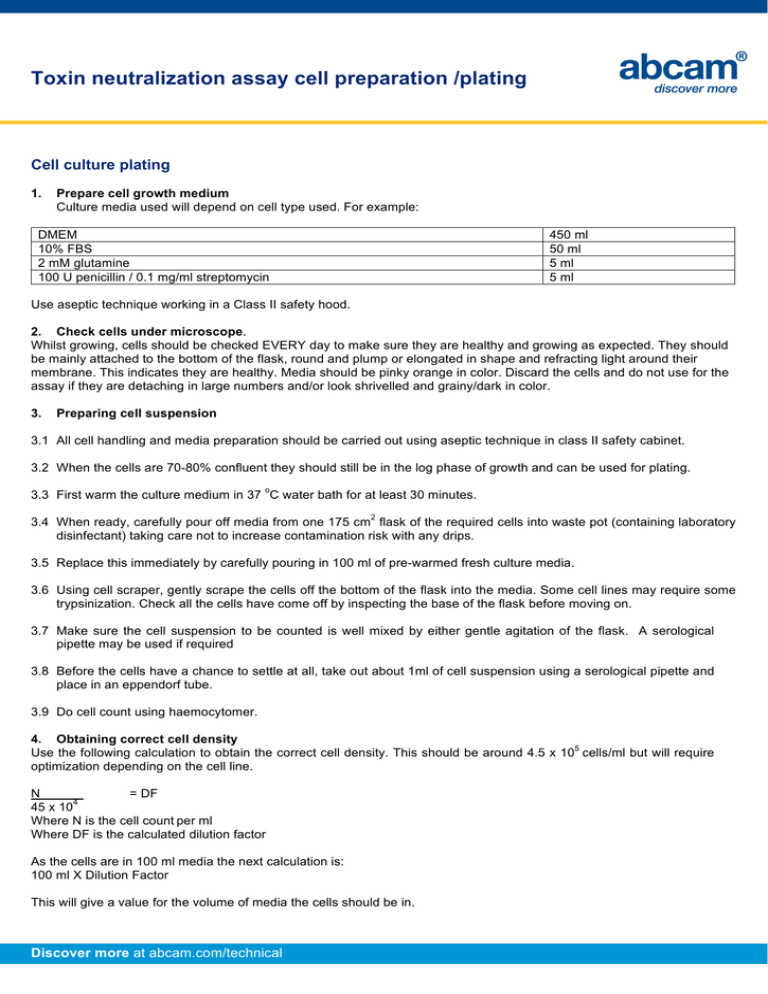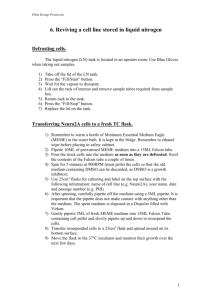Toxin neutralization assay cell preparation /plating Cell culture plating
advertisement

Toxin neutralization assay cell preparation /plating Cell culture plating 1. Prepare cell growth medium Culture media used will depend on cell type used. For example: DMEM 10% FBS 2 mM glutamine 100 U penicillin / 0.1 mg/ml streptomycin 450 ml 50 ml 5 ml 5 ml Use aseptic technique working in a Class II safety hood. 2. Check cells under microscope. Whilst growing, cells should be checked EVERY day to make sure they are healthy and growing as expected. They should be mainly attached to the bottom of the flask, round and plump or elongated in shape and refracting light around their membrane. This indicates they are healthy. Media should be pinky orange in color. Discard the cells and do not use for the assay if they are detaching in large numbers and/or look shrivelled and grainy/dark in color. 3. Preparing cell suspension 3.1 All cell handling and media preparation should be carried out using aseptic technique in class II safety cabinet. 3.2 When the cells are 70-80% confluent they should still be in the log phase of growth and can be used for plating. o 3.3 First warm the culture medium in 37 C water bath for at least 30 minutes. 2 3.4 When ready, carefully pour off media from one 175 cm flask of the required cells into waste pot (containing laboratory disinfectant) taking care not to increase contamination risk with any drips. 3.5 Replace this immediately by carefully pouring in 100 ml of pre-warmed fresh culture media. 3.6 Using cell scraper, gently scrape the cells off the bottom of the flask into the media. Some cell lines may require some trypsinization. Check all the cells have come off by inspecting the base of the flask before moving on. 3.7 Make sure the cell suspension to be counted is well mixed by either gentle agitation of the flask. A serological pipette may be used if required 3.8 Before the cells have a chance to settle at all, take out about 1ml of cell suspension using a serological pipette and place in an eppendorf tube. 3.9 Do cell count using haemocytomer. 4. Obtaining correct cell density 5 Use the following calculation to obtain the correct cell density. This should be around 4.5 x 10 cells/ml but will require optimization depending on the cell line. N = DF 4 45 x 10 Where N is the cell count per ml Where DF is the calculated dilution factor As the cells are in 100 ml media the next calculation is: 100 ml X Dilution Factor This will give a value for the volume of media the cells should be in. Discover more at abcam.com/technical Add the correct amount of pre-warmed culture media using serological pipette. Example: 4 If the cell count is 55 x 10 /ml and there is 100ml of cell suspension: 4 55 x 10 cells / ml = 1.22 4 45 x 10 cells / ml 100 ml x 1.22 = 122 ml 4 Therefore: for a cell suspension of 45 x 10 / ml add 22 ml pre-warmed culture media to the 100 ml of cell suspension N.B If volume required for the correct cell density is less than 100 ml: Pour cells into 50 ml centrifuge tubes. Spin in centrifuge at 1000 rpm for 10 minutes, making sure the centrifuge is balanced. Carefully pour off supernatant Resuspend cell pellets in required volume of prewarmed culture media. 5. Plating out the cells 5.1 Once the cells are resuspended in the correct amount of culture media, make sure the cells are well mixed by using a cell scraper to scrape off any cells that may have settled in the flask while waiting for the count. Carefully pour some cell suspension into a Petri dish ready for plating. 5.2 Using a multichannel pipette and 300 µl pipette tips, pipette 200 µl of cell suspension from the petri dish into each well of the required 96 well culture plates. These plates should be labelled with the assay number, plate number and date. N.B Make sure the cells are well mixed at all times by gentle agitation of the flask each time the Petri dish is filled back up as required and mixing every now and again while pipetting. 5.3 Place cell culture plates into a 37 C CO2 incubator overnight before using for an assay. o Discover more at abcam.com/technical





